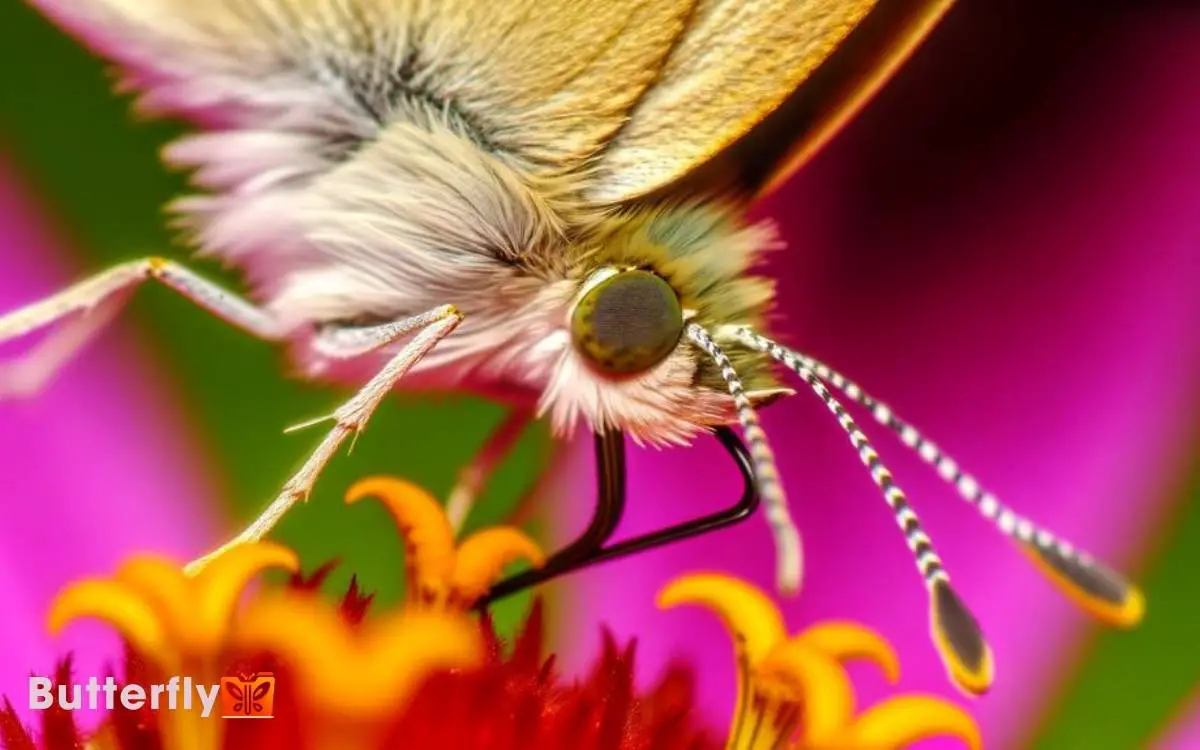How Do Butterflies Taste Things? Using Chemoreceptors!
Butterflies taste things using chemoreceptors on their feet. When they land on a flower, these sensors detect sugars, salts, and amino acids.
The information is quickly processed by their nervous system to assess the flower’s nutritional value. This precise tasting ensures butterflies select the most nutritious nectar, which is essential for their energy intake, survival, and reproduction.
While other insects use different body parts to taste, butterflies rely heavily on their feet to find the best food sources. Stay tuned to understand why this unique adaptation is important for their lifecycle and evolutionary success.

Key Takeaways
Butterfly Sensory System
Butterflies have a unique sensory system that allows them to taste with their feet, a fascinating adaptation for locating food sources and suitable plants for laying eggs.
You’ll find that their feet contain chemoreceptors, specialized sensory cells that detect chemical signatures.
These chemoreceptors send signals to the butterfly’s brain, helping it identify specific plant compounds.
This sensory mechanism enables butterflies to efficiently distinguish between different plants, ensuring they choose the most nutritious options for feeding and the best hosts for their larvae. Additionally, this system aids in avoiding toxic plants, which could harm them or their offspring.
Understanding this sensory system highlights how butterflies have evolved intricate methods to interact with their environment and secure their survival.
Role of Feet in Tasting
You might be surprised to learn that butterflies taste with their feet, thanks to specialized chemoreceptors.
When a butterfly lands on a flower, these receptors detect chemical signals, assisting it in evaluating the nectar’s quality.
This unique ability guarantees butterflies select the most nutritious and suitable flowers for feeding.
Chemoreceptors on Butterfly Feet
Most people don’t realize that butterflies use chemoreceptors on their feet to taste and assess the suitability of plants for laying eggs. When a butterfly lands on a leaf, it performs a delicate dance, tapping its feet to release chemicals from the plant.
These chemoreceptors detect specific compounds, informing the butterfly whether the plant is a vital host for its larvae.
Here’s a breakdown of key elements:
| Element | Function | Importance |
|---|---|---|
| Chemoreceptors | Detect chemical compounds | Essential for host plant selection |
| Feet Movement | Facilitates chemical release and detection | Ensures thorough plant assessment |
| Plant Compounds | Provide chemical signals | Indicate plant suitability |
| Egg-Laying Sites | Sites selected based on chemical detection | Guarantees larval survival |
| Sensory Signals | Processed by butterfly’s nervous system | Guides behavior and decisions |
Understanding these chemoreceptors highlights the intricate relationship between butterflies and their environment.
Tasting Through Foot Contact
When a butterfly lands on a plant, its feet press down, allowing chemoreceptors to detect the specific chemical composition of the surface, thereby enabling precise tasting and assessment.
These chemoreceptors respond to various chemical stimuli, sending signals to the butterfly’s brain. You might imagine these chemoreceptors as tiny sensors that analyze the plant’s surface.
The butterfly’s feet, hence, play an essential role in differentiating between suitable and unsuitable plants for feeding or laying eggs. This sensory input is important for survival, as it helps butterflies identify nectar sources and host plants with the right nutrients.
Role in Nectar Selection
By utilizing the chemoreceptors on their feet, butterflies can accurately determine the nutritional value and suitability of nectar sources, guaranteeing they select the best flowers for feeding.
When a butterfly lands on a flower, its feet immediately begin analyzing the chemical composition of the nectar. These chemoreceptors detect sugars, salts, and amino acids, allowing the butterfly to gauge the nectar’s energy content.
If the nectar meets their dietary needs, the butterfly will extend its proboscis to drink. This precise mechanism guarantees that butterflies optimize their energy intake, vital for their survival and reproduction.
You can see how their feet play a pivotal role in their feeding strategy, enabling them to make quick, informed decisions about which flowers to visit.
Function of Antennae
You’ll find that butterfly antennae are essential for detecting chemical signals in their environment.
These sensory receptors, located on the antennae, allow butterflies to perceive pheromones and other chemical cues.
This ability is important for locating food sources, mates, and suitable habitats.
Sensory Receptors Location
Butterflies rely on the dense array of sensory receptors located on their antennae to detect chemical signals and navigate their environment.
These receptors, known as chemoreceptors, are highly specialized and sensitive to various compounds in the air. They play a vital role in helping butterflies find food, mates, and suitable habitats.
| Antennae Function | Description |
|---|---|
| Chemical Detection | Identifies pheromones and other chemical cues. |
| Navigation | Assists in orienting and locating resources. |
| Environmental Sensing | Detects changes in temperature and humidity. |
The antennae’s design, featuring numerous sensory hairs, enhances their ability to sense minute chemical changes, ensuring the butterfly’s survival and reproductive success.
Understanding these functions reveals the complexity of butterfly behavior and their interaction with the ecosystem.
Chemical Signal Detection
The intricate network of chemoreceptors on butterfly antennae enables them to detect even the faintest chemical signals in their environment.
These specialized sensory cells respond to a variety of chemical cues, such as pheromones and floral scents, by binding to specific molecules.
When you observe a butterfly waving its antennae, it’s actively sampling the air for these signals. This vital process is essential for finding food, mates, and suitable habitats.
The chemoreceptors send electrical impulses to the butterfly’s brain, where the chemical data gets processed into actionable information.
By understanding how these chemoreceptors function, you’ll gain insight into the sophisticated ways butterflies interact with their ecosystem, ensuring their survival and reproduction.
Nectar Identification Process
When identifying nectar, butterflies rely on a sophisticated combination of gustatory receptors located on their proboscis and feet. These receptors can detect specific chemical compounds present in nectar.
As a butterfly lands on a flower, it uses its feet to sense the initial taste of the nectar. If the chemical signals are important, the butterfly then unfurls its proboscis to sample more deeply.
The proboscis receptors further analyze the nectar’s composition, confirming it contains the necessary sugars and nutrients.
Your understanding of how butterflies taste allows you to appreciate their intricate process of selecting the best nectar sources, which is vital for their survival and energy. This dual-receptor system ensures precise identification and efficient feeding.
Importance of Taste Receptors
Understanding the butterfly’s dual-receptor system highlights the pivotal role taste receptors play in their survival, guiding them to nutrient-rich nectar sources.
You see, butterflies have gustatory receptors on their feet and proboscis. These specialized cells detect chemical cues from plants, enabling butterflies to identify suitable nectar and oviposition sites.
When a butterfly lands on a flower, its feet taste the plant, evaluating its suitability before feeding. This immediate feedback loop guarantees they don’t waste energy on non-nutritive sources.
Additionally, the proboscis, equipped with taste receptors, further refines this selection process.
By differentiating between beneficial and harmful substances, these taste receptors are essential for maximizing energy intake and reproductive success, ensuring butterflies thrive in their environments.
Nutritional Needs and Tasting
Butterflies rely on their exquisite sense of taste to meet their specific nutritional requirements, ensuring they consume the best balance of sugars, amino acids, and minerals necessary for survival and reproduction.
With taste receptors located on their feet, butterflies can immediately determine the nutritional content of a potential food source.
They specifically seek:
- Sugars: For immediate energy.
- Amino Acids: Essential for protein synthesis.
- Minerals: Critical for various physiological functions.
- Sodium: Often sourced from puddles, aiding in osmotic balance.
- Vitamins: Supporting overall metabolic processes.
Survival and Reproduction
By meticulously selecting their food sources, butterflies not only secure their nutritional needs but also enhance their chances of successful survival and reproduction.
They use chemoreceptors on their feet to taste potential host plants, guaranteeing they lay eggs on the most nutritious leaves. This careful selection process guarantees their larvae, or caterpillars, have a prime food source upon hatching, critical for early development.
Additionally, adult butterflies seek out nectar-rich flowers, which provide necessary energy for mating flights and egg production.
The ability to taste and discern appropriate food sources directly impacts their reproductive success, as well-nourished butterflies are more likely to reproduce and pass on their genes. Therefore, tasting is integral to a butterfly’s lifecycle and evolutionary success.
Comparisons to Other Insects
Lastly, comparing butterflies to other insects reveals fascinating differences and similarities in their sensory adaptations, particularly in how they use taste to interact with their environment. For example, butterflies rely on their feet to taste plants, allowing them to quickly identify suitable locations for laying eggs. In contrast, bees use their mouthparts and antennae to detect floral nectar, which plays a crucial role in the process of butterflies vs bees pollination. These distinct sensory adaptations highlight how each insect has evolved to optimize its survival and reproductive success.
Unlike many insects, butterflies have taste sensors on their feet, enabling them to taste surfaces by landing on them.
In contrast, bees use their antennae to detect floral nectars. Ants employ their mandibles and antennae to taste food sources directly.
Flies use taste receptors on their proboscis and feet, similar to butterflies but with different behavioral patterns. Finally, beetles generally have taste sensors located in their mouthparts for food identification.
Understanding these differences illuminates the diverse evolutionary paths insects have taken.
Conclusion
Imagine you’re a butterfly, tasting the world through your feet as if stepping onto a vibrant, sensory-rich canvas. Your antennae, precise instruments, guide you to life-sustaining nectar. Each taste receptor is a key, revealing essential nutrients crucial for survival and reproduction.
Unlike other insects, your intricate tasting mechanism guarantees you thrive in nature’s tapestry. So, next time you see a butterfly, remember they’re not just flitting about—they’re savoring life’s delicate flavors.






